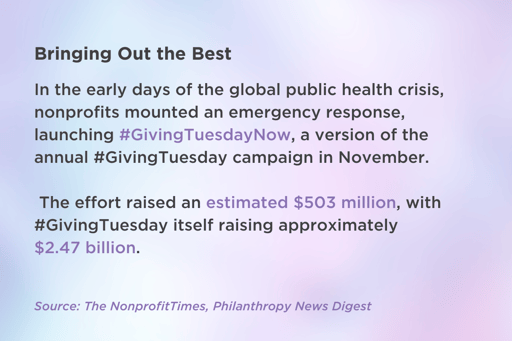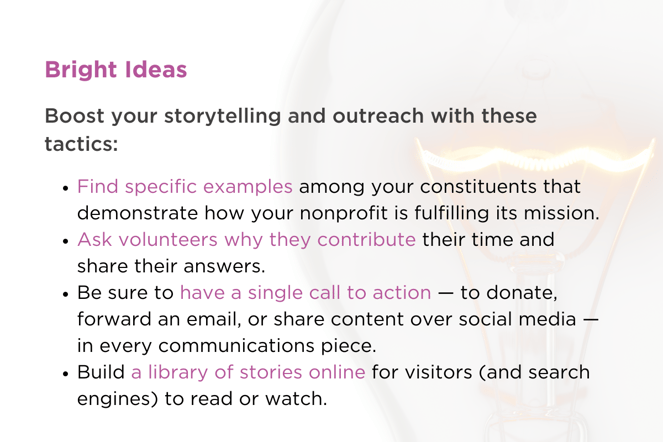The Ultimate Guide to Year-End Fundraising for Nonprofits | Evaluating and Planning
Come October, you start seeing them: postcards and fat envelopes from charities reminding you of those less fortunate and the tough times ahead during the upcoming holiday season — the meals they’ll do without, the gifts they can’t provide their kids, the coats they need to stay warm. You’ll see these appeals begin popping up in your inbox, too, especially if you’ve donated to those organizations in the past. Your social media feeds will probably echo similar requests for aid, particularly during the #GivingTuesday that follows Cyber Monday.
Combined with the charitable mindset that the holiday season encourages, these messages find a more receptive audience, which is why year-end fundraising is so important to nonprofits. In fact, according to Winspire, an experiential agency for charity auctions, 50 percent of nonprofits receive the bulk of their donation revenue in the last three months of the year. December is especially significant, with more than a third of annual giving occurring that month — indeed, 52 percent of first-time donors who contribute in December give larger gifts than those who donate at any other time of the year. This generosity is further concentrated, with 10 percent of annual giving occurring on the last three days of the year (hi, tax write-offs!).
No wonder, then, that nonprofits put so much emphasis on their year-end fundraising, which is why we’ve created this guide to assist organizations looking to improve their efforts or reboot their approach towards year-end giving. And there should be cause for hope and optimism this year: The Lilly Family School of Philanthropy has predicted overall charitable giving will grow 4.1 percent in 2021 and 5.7 percent in 2022. The resumption of stable business and economic conditions is likely to fuel broad philanthropic growth in the years ahead, researchers say.
Whether your nonprofit has a tried-and-true process or whether you’re just beginning to think about your year-end fundraising, there’s something here for everyone, with tips and tricks for organizations large and small, established or newly minted. Shall we begin?
Phase 1: Evaluate & Plan
You want to give yourself plenty of time to not only plan your year-end fundraising, but also to develop all the assets you’ll need for it: copy for your email appeals, time to get digital files to the printer for your mailers, and so on. While about 52 percent of nonprofits begin to plan in October, it’s never too late (or too early) to start.
Set yourself up for success by first assessing your previous year-end fundraising efforts. Doing so will give you benchmarks against which you can compare the strategies and tactics you take this year against past years and the results that each yielded. It will also identify any holes in your data collection so that you can patch those up and begin gathering the information you need to bolster your fundraising.
What exactly do you need to know?
Here’s a common list of data you should compile; all should compare year-over-year (YOY) figures:
- Who gives where? Determine your donors by channel: direct mail, event, text, social media, direct mail, in-person visit.
- Number of new donors acquired
- Number of donors lost
- Average gift size
- The increase or decrease in average gift size
- Total dollars raised
- The rise in overall growth percentage
This data will likely inform not just your year-end fundraising, but other initiatives too, so if you haven’t been gathering this information already, pat yourself on the back for harvesting it now.
Digging Deeper: Segmenting Your Donors
While you’ve done the hard work of learning the channels in which your donors have best responded, there’s more to be done. Remember, many of us have become accustomed to personalized outreach and services. Whether that’s online retailers who remember your past purchases or streaming services such as Spotify and Netflix that suggest content tailored to your tastes, we now expect services to cater to us individually. It’s no different with the charities and causes we support.
And with the flood of emails and marketing from merchants and other nonprofits that yours competes with during the holiday season, why not stand out from the rest by addressing each donor or potential donor personally? Let’s look at the ways you can do that.
- Segment by communication preference. You already did a bit of this splicing when you researched past donors and the touchpoint through which they contributed. Now parse that data even finer by segmenting them by their preferred communication channel, as well as how frequently — daily, weekly, monthly — they like to hear from you.
- Segment by giving level. Group individuals by the ways they interact with your organization: non-donors, volunteers, general fund, mid-level, major donors, etc. Shape your communications to their specific contributions.
- Segment by interests. Which programs do your donors contribute to or participate in? For example, a social service agency may have a homeless outreach program or coordinate meals-on-wheels for the elderly. Or an animal welfare organization may find volunteers lean towards cats versus dogs. By understanding your donors’ or prospective donors’ giving affinity, you can align their passion with the needs of your organization.
- Segment by giving frequency. One-time, annual, or recurring — your supporters have different giving preferences. Customize your communications to speak to (and potentially upgrade) their selections.
By segmenting your donors in these categories, you can offer them a more personalized experience and show that you’re listening and value their unique contributions.
Setting Goals
Armed to the teeth with data, you can now set milestones for your year-end fundraising and have those map to larger organizational goals. Once you’ve established them, for instance, you’ll want to figure out how you’ll measure your progress. Do you need to set up special formulas for your spreadsheets or databases? Do you need to purchase specialized software? Whose responsibility will it be to track that information?
Next, look into what drives donations (last-minute or otherwise) and incorporate that into your plans. For example, should you change the color of your donate buttons? Some studies say certain colors drive greater engagement.
What about the content of your emails? Look at your clickthrough rate (CTR), the best measure of engagement, and see if there’s language or content that regularly motivates recipients to take action. Research industry findings to see what’s best for your field because what works for major retailers may not be suitable for your organization or audience.
Lastly, develop “reach” or challenge goals for your team. Incentives such as a gift card to a local shop or a team dinner at a favorite restaurant can provide extra motivation as well as fuel momentum.
Consider applying this tactic to fundraising communications to would-be donors as well. For example, you could establish a gift-match campaign and remind donors of the limited time in which they can have their gift doubled or tripled. (Washington National Cathedral did this and raised double its goal.) You might also launch this effort during #GivingTuesday to increase your chances of reaching that challenge milestone.
The All-Important Communications Plan
You know the results of your past year-end giving efforts, you’ve set goals for this year, and you’ve figured out how you’re going to measure your progress towards them. Now how do you plan to convince past donors to give again (and at higher amounts or greater frequency) and potential supporters to contribute?
A thoughtful, well-designed communications plan is your ticket. Drawing donors in means helping them understand the beating heart of your organization. Too often, communications to them fail to adequately engage their passion for the causes your organization champions.
And while your nonprofit may be doing the championing, remember that donors should be the hero of your fundraising story. Elevate their contributions and use the insights you gained from segmenting your file to tell a story that puts donors at the center.
Bonus resource: Download our tried-and-true communications channel plan.
How to Create a Compelling Story
Charitable giving is inherently altruistic, but focusing on donors’ interests goes a long way towards getting them there. By segmenting your file, you’ll have a better sense of what compels your audience and can shape your communications around that data. For instance, if you know a donor has kids, you can tell a story about how their donation will support your organization’s after-school program for at-risk youth. By building campaigns around experiences that relate directly to donors’ lives and interests, you can produce meaningful stories that stir emotions and compel your audience to act.
Some donors may be more data-driven or require proof that their dollars will be effective. Provide specifics on how their donations support your organization’s work, such as how many houses their donations helped build or the number of cancer patients your hospital treated. Hard data like that reassures donors that their contributions have meaning — they may even be inspired to give more!

At the start of your campaign, you’ll want to focus your year-end fundraising communications on the organization’s mission but build a sense of urgency as the clock ticks down on the year. FamilyLife took that tack and saw a 10 percent bump in the number of donors and an 8 percent lift in revenue year over year.
Ready, Set, Go!
You compiled the needed data and devised a communications plan — ready to act? Not so fast. You’ll want to confirm that all the tools and relationships you need are in place before moving forward.
Take tools, for instance. Earlier, we mentioned making sure you had the right software to organize existing data and to track new data as it comes in. You should also have a tool that provides your nonprofit with in-depth profiles of your supporters so that you can quickly segment them in the ways we described above. Pursuant’s GivingDNA is the only tool on the market that does that. From the donation history of your constituents to their professional and educational backgrounds, the GivingDNA platform can optimize your year-end fundraising.
You should also consider marketing automation tools that facilitate rapid responses to donor engagement, such as personalized thank-you emails that automatically deploy when a constituent makes a donation. Remember, too, that many digital tools and platforms offer nonprofits discounted rates.
Next, you’ll want to make sure that the right relationships have been established. Besides selecting the vendors who may shoot your campaign video or write your email copy, you should research the social influencers interested in your cause or mission. Sometimes that can be a well-known celebrity with a large Instagram following; other times, it can be a nano influencer with a smaller but highly engaged following. Occasionally, it can be another organization with an audience or mission-related to or adjacent to yours. Relationships with these social media influencers or partners can prove highly beneficial, so reach out to them and begin building rapport well before you plan to launch your campaign. No one likes to feel as though the relationship is purely transactional.
